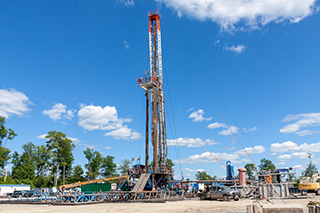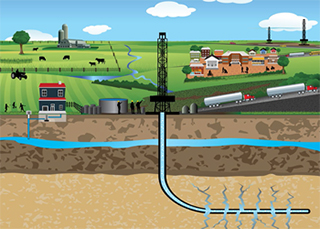Introduction
What is hydraulic fracturing?

Hydraulic fracturing, or fracking, is a method used to extract natural gas and oil from deep rock formations known as shale. Using this method, drilling operators force water, sand, and a mix of chemicals into horizontally drilled wells, causing the shale to crack and release natural gas or oil.
Hydraulic fracturing is part of a broader process known as unconventional natural gas development, which refers to all operations from well construction to the transport of gas and oil away from the drilling site.
Does hydraulic fracturing pose health risks to the people living near drilling sites?
Residents, environmental advocates, and researchers are concerned about potential health effects and environmental impacts. Water quality is a primary concern because the hydraulic fracturing fluids used to fracture rock formations have chemicals that could harm human health and the environment, especially if they enter drinking water supplies. Other concerns relate to chemicals that are recovered and disposed of as wastewater. Emissions of air pollutants are another potential hazard.
More than two decades since the rapid expansion of unconventional natural gas extraction, researchers are now uncovering the scope of associated health effects and related costs. In some areas, such as Colorado, Oklahoma, Pennsylvania, and Texas, oil and natural gas extraction and development may occur close to residential communities. Research has provided some evidence about how unconventional natural gas development affects the health of those people in nearby communities.
More than two decades since the rapid expansion of unconventional natural gas extraction, researchers are now beginning to grasp the scope and extent of associated health effects and related costs. Mounting evidence related to environmental effects shows a need to analyze and quantify health and socioeconomic impacts using a common metric.
Water quality
Chemicals associated with natural gas and hydraulic fracturing may travel through cracks in the rock into an underground drinking water source. Water contamination could also occur if a well is improperly installed, if chemicals are spilled from trucks or tanks, or if flowback is not effectively contained. Flowback is when water used in the hydraulic fracturing process flows out of the well.
The EPA found scientific evidence that hydraulic fracking activities can affect drinking water resources under some circumstances. The extent of water contamination from these sources is currently unknown.
Indirect evidence shows water contamination related to fracking influences health. But direct evidence is needed.
Air quality
Drilling sites may affect local air quality in several ways. Any related combustion process can release toxic chemicals into the air. For example, the burning off, or flaring, of excess natural gas; the operation of heavy equipment at the well site; and the use of diesel trucks to transport materials to and from a site may all contribute to air pollution. In addition, the chemicals and sand used in the hydraulic fracturing process, as well as other chemicals that surface with the natural gas, have potential to affect air quality.

Because operators are not always required to divulge the specific chemicals used, the extent of air pollution and potential dangers to local communities are not well understood.
A review study published in 2019 synthesized research on relationships between hazardous air pollutants (HAPs) and upstream oil and gas development, which may or may not include fracking. The study found that HAP compounds associated with multiple cancer and noncancer health outcomes have been detected near development sites at levels that exceed health-based standards and reference concentrations.
The researchers found that the production phase has potential to emit the highest concentrations and most varied mixture of air pollutants over the longest time period. They also concluded that potential exposures are higher if production equipment is located in the same areas with storage tanks for natural gas liquids and wastewater ponds.
Research findings suggest that air pollutants from unconventional oil and gas exploration are associated with adverse health effects in older adults, according to a 2022 study. The researchers found that older adults who lived near or downwind of unconventional oil and gas development sites had a higher risk of premature death than those living upwind.
Community impacts
A drilling site can affect community well-being, in positive and negative ways. For example, a drilling operation can increase local employment rates. Activities related to drilling can also negatively affect a community. These effects may include increased noise, light, and traffic, heavier burdens on local infrastructure and resources, such as roads and hospitals, and other physical changes to a community’s character.
Are there health risks to the people who work at drilling sites?

Health risks to workers at unconventional natural gas development sites include accidents that are often associated with industrial occupations involving heavy equipment. Research is ongoing, but these hydraulic fracturing-specific health risks have been identified for workers:
- Inhalation of silica sand: Without proper protection, workers may breathe in fine particles of silica sand during the hydraulic fracturing process. Inhaling these particles can cause lung diseases.
- Exposure to chemical spills: Accidental spills may expose workers to chemical compounds used in the hydraulic fracturing process, presenting a variety of health risks.
- Exposure from flowback operations: Field studies suggest that workers performing certain operations may be exposed to high levels of volatile hydrocarbons, which could be toxic.
What is NIEHS Doing?
NIEHS provides funding for research and community outreach to investigate and address potential public health impacts related to hydraulic fracturing.
- A multi-year study, published in 2022, found that children who, at birth, resided within 2 kilometers of at least one well for unconventional oil and gas development had nearly twice the chance of developing acute lymphoblastic leukemia. It is the most common form of childhood leukemia.
- A 2021 study linked cardiovascular risks with unconventional natural gas development. The study found increased hospitalization rates for acute myocardial infarction, also known as heart attack, among middle-aged and older men, and older women, who live in Pennsylvania counties that overlay the Marcellus Shale.
- NIEHS-funded researchers found that pregnant women who lived near active oil and gas wells had a greater chance of having low birth weight babies. This study, published in 2020, quantified prenatal exposures to also evaluate differences in associations by rural and urban areas in California. Being born at low birth weight or small for gestational age can affect development and future health in children.
- A previous study, published in 2018, of women living near hydraulic fracturing sites in the Barnett Shale area of Texas found a risk of extreme preterm birth.
- In a 2017 study of nearly 24,000 primary care patients in central and northeast Pennsylvania, residential unconventional natural gas development was associated with nasal and sinus symptoms, migraine headache, and higher levels of fatigue.
- A 2016 study, published in JAMA Internal Medicine, evaluated risk of worsening asthma for more than 35,000 asthma patients living near unconventional natural gas development sites in Pennsylvania. Researchers found such activity near patient residences was associated with an increased chance of mild, moderate, and severe asthma exacerbations.
Further Reading
Stories from the Environmental Factor (NIEHS Newsletter)
- Children Born Near Fracking Sites Have Higher Leukemia Risk (November 2022)
- Nearness to Oil and Gas Wells Linked With Low Birth Weight (July 2020)
Additional Resources
National Clearinghouse for Worker Safety and Health Training - Find resources that address environmental and occupational health hazards associated with hydraulic fracturing operations, also known as fracking.
Related Health Topics
This content is available to use on your website.
Please visit NIEHS Syndication to get started.

